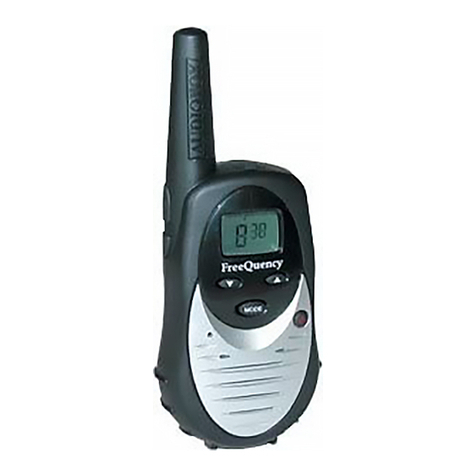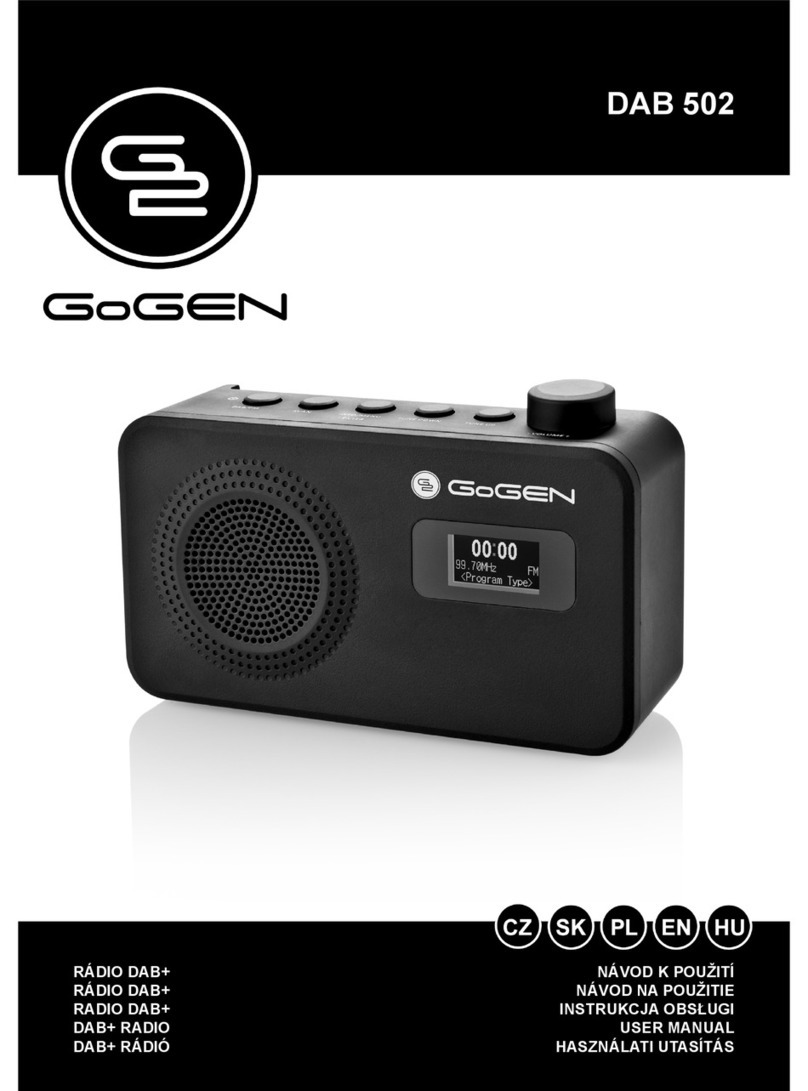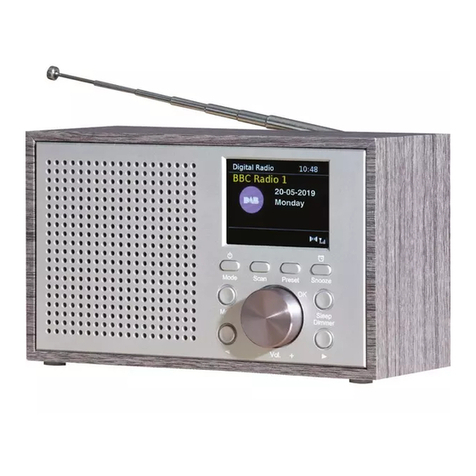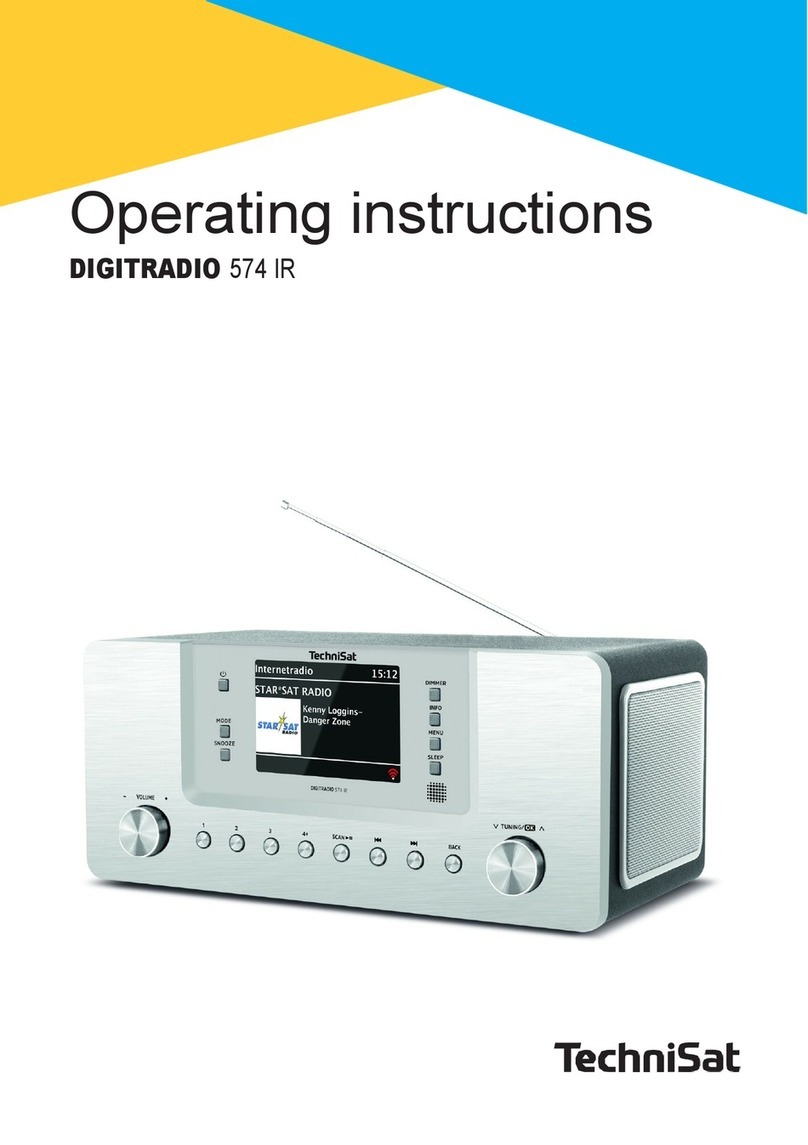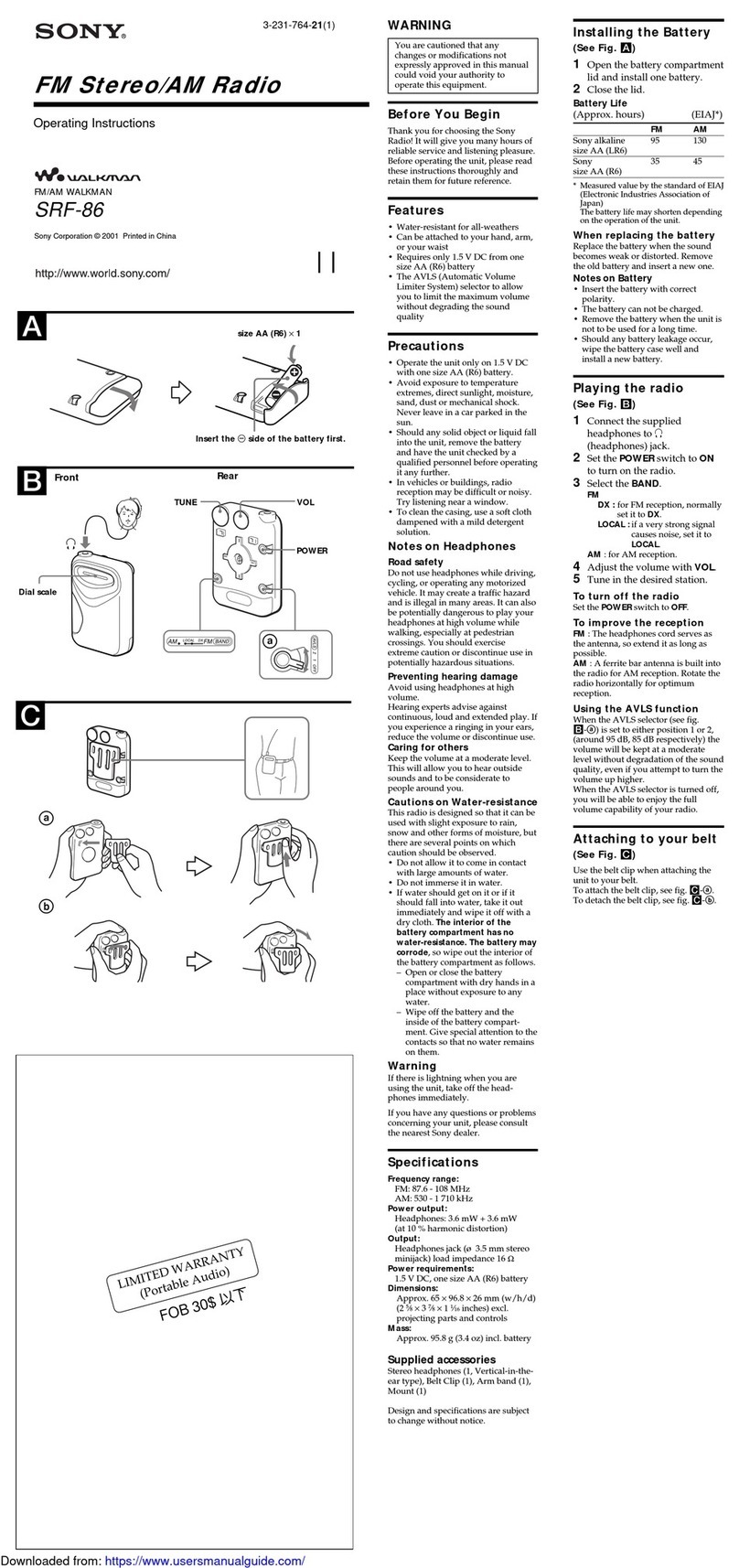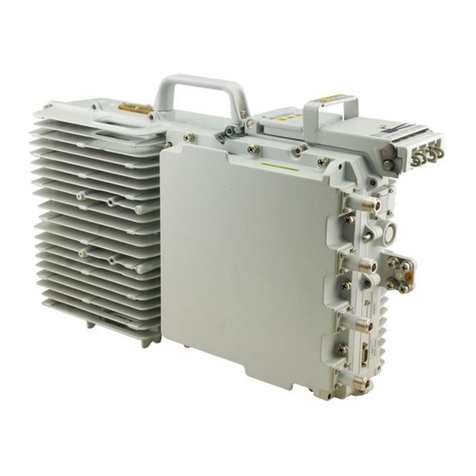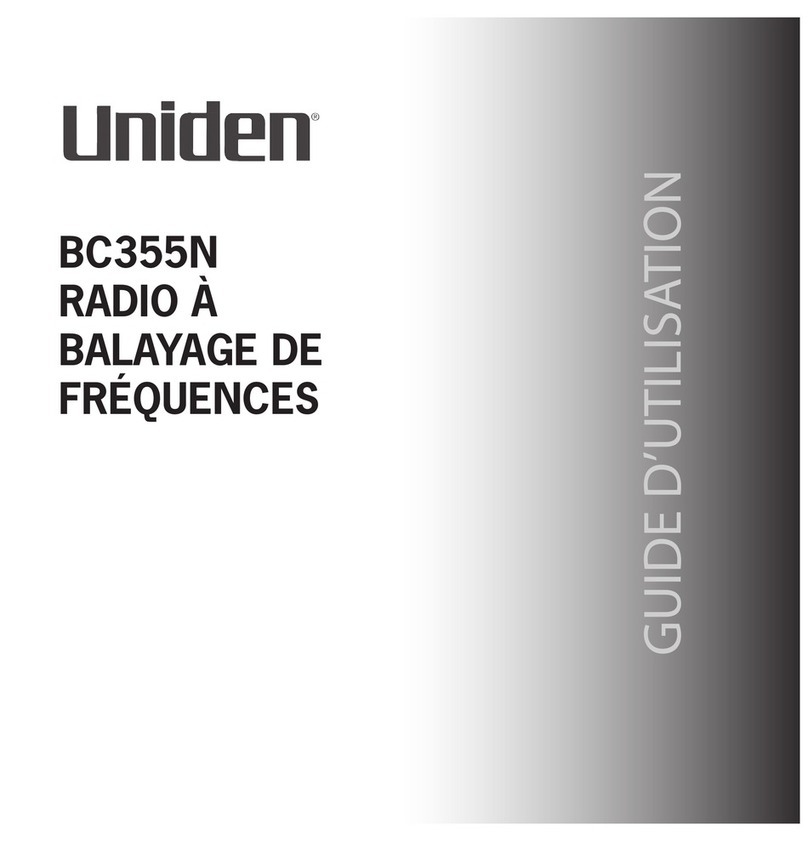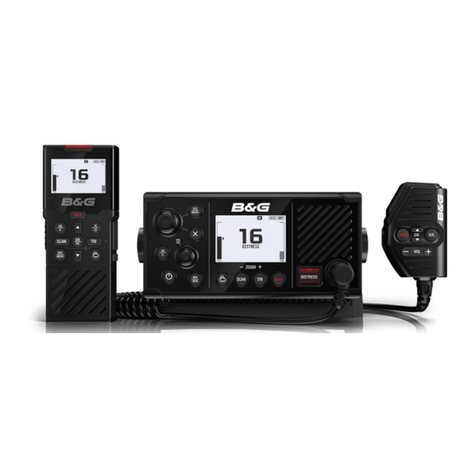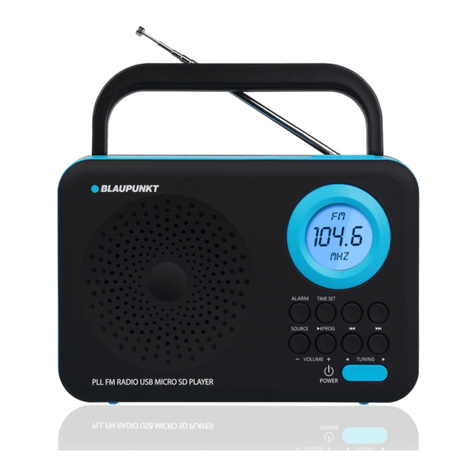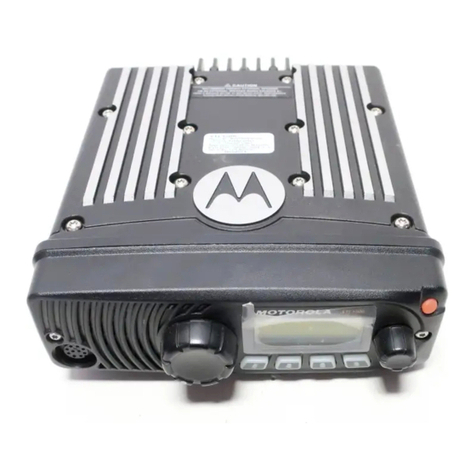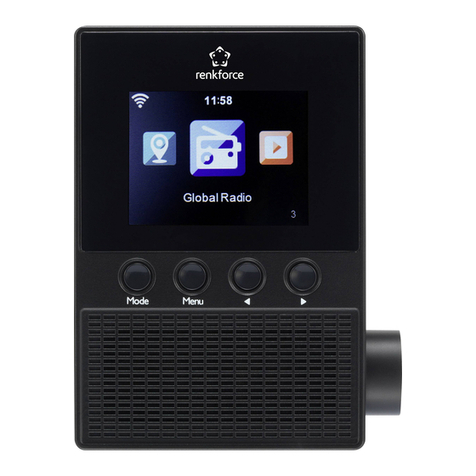tti Tech PMR-446 User manual

service
manual
PMR-446 Radio
TX-446
TTI Tech

SECTION 1 SPECIFICATIONS
SECTION 2 INSIDE VIEWS
SECTION 3 CIRCUIT DESCRIPTION
3-1 MICROPROCESSOR / CONTROL SECTION
3-2 VCO / SYNTHESIZER SECTION
3-3 TRANSMITTER SECTION
3-4 RECEIVER SECTION
3-5 BATTERY SECTION
4-1 GENERAL
4-2 SYNTHESIZER / TRANSMITTER
4-3 TRANSMITTER ALIGNMENT
4-4 RECEIVER ALIGNMENT
SECTION
5-1 ELECTRICAL PART LIST
5-2 MECHANICAL PART LIST
7-3 BATTERY PCB
4 ADJUSTMENT PROCEDURES
SECTION
7-1 MAIN PCB
7-2 SWITCH PCB
5 PART LIST
SECTION 6 MECHANICAL DISASSEMBLY
SECTION
9-1 MAIN PCB
9-2 BATTERY PCB
7 BOARD LAYOUT
SECTION 8 BLOCK DIAGRAM
SECTION 9 CIRCUIT DIAGRAM
TABLE OF CONTENTS
1

8 ch
Frequency Range 446.00625 - 446.09375 MHZ
12.5 MHZ
6.25 KHZ
7.5 V, Nominal
Squelched (w/Power Saver) 24 mA, Typical
Squelched (w/out Power Saver) 50 mA, Max.
Rated Audio 160 mA, Max.
Transmit 0.5mW (ERP) 800 mA, Max.
Antenna Impedance 50 ohms
Speaker Impedance 8 ohms
Frequency
Stability
(0 ~ 30 )
(-20 ~0 and 30 ~50 )
1.5 KHz
2.5 KHz
2.5 KHz
Operation Temperature -20 to +50
500 mW (ERP)
-36 dBm (9 KHz to 1 GHz)
-30 dBm (above 1 GHz)
Modulation
FM Hum and Noise -36 dB Typical
Audio distortion 5 % Max.
Sensitivity (12dB SINAD) 0.35 Max.
Squelch sensitivity 10 dB SINAD Typical
- 60 dB Min.
- 70 dB Min.
Intermodulation ETS - 65 dB Min.
-40 dB TypicalHum and Noise Ratio
400nM at 5% T.H.D. (1 KHz)Rated Audio Output
Spurious/Harmonic Emissions
Adjacent Channel Selectivity ETS
Spurious Rejection
TRANSMITTERRECEIVER
SpecificationParameter
Number of Channels
Channel Specing
Channel Increments
Battery Voltage
RF Output Power
SECTION 1 SPECIFICATIONS
Power Requiremnts
Current
Drain
GENERAL
Size (W x D x H) 132 x 56 x 36 mm
Weight (With Battery and Antenna) 400 g
2

RV503
(CTCSS,
DCS Blance ADJ.)
RV501
(MOD ADJ.)
RV101
(CTCSS,
DCS Devation ADJ.)
TP1
(VCO Lock Voltage Detect)
CV301
(Frequency ADJ.)
TP3
TX-446 ADJUSTMENT POINT
SECTION 2 INSIDE VIEWS
3

SECTION 3 CIRCUIT DESCRIPTION
GENERAL INFORMATION
The TX-446 has four printed circuitboards. (Main PCB, SW PCB and two BATT PCB in battery pack.)
Circuitry is described in the following order: Microprocessor/Control Section, VCO/Synthesizer Section,
Transmitter Section, Receiver Section and Battery Section. Refer to the Block Diagram and the Schematics.
3-1 MICROPROCESSOR / CONTROL SECTION
The microprocessor Q106 isconstantlyoperating when the radio isturned ON. It iscontinuouslymonitoring the
keyboard, the PTT line and other internal inputs such as the squelch detect, etc. When a change occurs, the
microprocessor makes the appropriateresponse. The microprocessor is used for control. The Radio emits a beep on
channel change and the synthesizer is loaded with the correct frequency information. The microprocessor runs
off a 4.19304 MHz oscillator which is composed ofX101, C117, C118, and R135.
When the radiois first turned on,the microprocessor reads the radio status from the EEPROM Q109.
The microprocessor determines the receive frequency codes, then loads the synthesizer via its pins 17, 18 and 19.
3-2 VCO / SYNTHESIZER SECTION
This sectionconsists ofthe Temperature-Compensated Crystal Oscillator (TCXO), Voltage Controlled Oscillator
(VCO), Synthesizer and the Loop Filter.
Temperature-Compensated Crystal Oscillator (TCXO)
The reference oscillator(X301) is a temperature compensated crystal- oscillator, CV301 is used to adjust the oscillator
on frequency (21.25MHz) at room temperature (22°C). Q311, Q310, R314, R316, R319, R333, R334, R335 etc.
Temperature compensated is held within the specified 2.5 KHz from -20 to +50°C.
Voltage-Controlled Oscillators
The VCO of oscillates 446.00625 MHz to 446.09375 MHs under the transmission condition and 424.30625 MHz to
424.39375 MHz under the reception condition. The VCO consist of the clip oscillator of the Q305 and contaions the
oscillator frequency of approximately 21.7 MHz during the transmission/reception conversion. That is since the VCO
should oscillate relatively low frequency during reception compared to transmission, the Q307 is biased by the Q309.
Therefore as a result, the C312 is added in parallel to the resonance circuit of the VCO to oscillate a low frequency.
During transmission, a relatively high frequency should be oscillate compared to receprion. Therefore, the Q307 is
adversely biased by the Q309, and as a result, the C312 which is added unparalleled to the circuit of the VCO is
removed the desired transmission frequency.
Synthesizer
The PL synthesizer of the signal loop PLL circuit with the reference of 6.25 KHz. The Q303 PLL IC includeds all the
function such as the reference oscillator, the driver, the phase detector, the lock detector, and the programmable divider.
At the reference oscillator, the 21.25MHz TCXO is connected to the pin 1 of the Q303 to oscillate the frequency of
21.25 MHz. The TCXO (21.25 MHz) is the temperature compensation circuit to maintain the frequency within the
allowable error rang even under a low temperature of -20 . The phase detector send out the output power to the loop
filter through pin 14 of the Q303, If the oscillation frequency of the VCO is low compared to the reference frequency,
the phase detector send out output power in postive pulse. If the oscillation frequency of the VCO is high, phase
detector send out can maintain the frequency set. The progammable maintains the desired frequency with control from
the microprocessor Q106.
Loop Filter
The Loop Filter, a passive lead-lag filter consisting of C318-C320, R312, R313 and R317 integrates the charge pump
output to produce the DC turning voltage for the VCO. One parasitic pole, consisting of C318/R312 and RF choke
L305 prevent modulation of the VCO by the 6.25 KHz reference energy remaining at the output of the loop filter.
Direct FM is obtained for modulating frequencies outside the PLL bandwidthe by applying the CTCSS/DCS signals
and the pre-emphasized, limited microphone audio to the VCO modulation circuit.
The modulation circuit consists of Q315, C343, R309, R340and R341.
4

3-3 TRANSMITTER SECTION
RF POWER Amplifier
The transmitter parts of the TX-446 is designed to amplify the RF signal oscillated and modulated by the synthesizer to
approximately 500mW by the power transistor of Q407.
The transmitted signal of approximately 7mW, combined at the driver FET is supplied to the gate of the Q407 amplifier.
The transmitted signal amplifier to 500mW here passes the TX LPF of the second characteristics of the C418-C421, L408,
PCB_L1and PCB_L2and RX/TX switching takes place by the Q406. After this, the signal is provided to the antenna the
TX LPF of the first characteristics consisted of the C427,C428,C432,L412,L413 and L414.
Antenna Switching
Switching of the antenna between the transmitter and the receiver is accomplished by the antenna transmit/receive
switch consisting of diodes Q404 and Q406 inconjunction with C415 and R414. In the transmit mode, switched TX B+
is applied through RF choke L415, hard forward biasing the two diodes on. Q406 thus permits the flow of RF power
from output of the low-pass filter fed by the output amplifier to the output low-pass filter. Q404 shorts the receiver input
to C415, which is AC coupled to ground. L407, C416, C415 and R414 then function as a lumped constant quarter-wave
transmission line, thus presenting a high impedance to the RF output path, effectively isolating the receiver input and
transmitter output sections.
POWER Control
Output power iscontrolled by the microprocessor Q106, which is used as a differential amplifier and comparator.
Current is sensed by the voltage drop across R417.
When the radiotransmitter mode, this voltage is compared to the one set bythe 500mW.
The power output is then reduced or increased by varying the applied to the power amplifier Q407.
Transmitter Audio Circuits
The transmitter audiocircuits consist ofthe audioprocessingcircuits, the CTCSS circuits andthe DCS circuits.
Audio Processing
Transmitspeed audio is providing by either the internal electric microphone E201 or the external microphone.
The microphone audio ispre-emphasized by 6dB per octave by C540 and R557, and then signal amplification and
applied to Lo-pass filter Q507D,Q505D.
The gain is such that when a signal 20dB greater than limiting the peak-to-peak output.
Under these conditions, the MOD. ADJ. Pot RV501 configured as a four-pole active low-pass filter.
The resulting signal is then limited when respect toside band splatter, and has an 18dB per octave roll-off above 3KHz.
The audio is then applied to transmit VCO. By varyingthe voltage on the varactor diode Q308 at an audio rate.
The resonant frequency ofVCO is varied. The result is an oscillator output that is frequency-modulated at the audio
frequency.
CTCSS Tone Encoder / Digital Code Squelch (DCS) Encoder
CTCSS signals and DCS signals are synthesized by microprocessor Q106 and appear as pulse waveform on I/O lines
Pin 4-8. These I/O lines are applied toa resistive digital-to-analog converter network (consisting of R128-R132) which
produce a pseudo-sine wave for CTCSS or a waveform for DCS at itsoutput. The waveform issmoothed by low pass
filters Q507C to produce an acceptable sine wave output. The CTCSS tone signal is adjust to the proper level by
RV101. The DCS signal is adjust tothe proper balance by RV503. The signal is then applied tothe audio processing
circuit at R305 andto the TCXO circuit at X301.
5

The Receive VCO (C306, L302,R306,C308,C310, Q305,C311, L304) provides the LO signal. The VCO is running
at 21.7 MHz below the desired receive frequency and is applied to output Buffer Q301. The output of the buffer through
the low-pass filter C407, R406, L405 and applied to the mixer Q403.
Mixer
The mixer is a FET type (Q403). The mixer LO frequency is 21.7 MHz below the desired receiver frequency
When the receiver frequency is present, the mixer output will be a 21.7MHz signal. The mixer output is peaked for
21.7MHz at L406, C409, C410and the signal is filtered by crystal filter XF401 and XF402 and amplified by Q405
before being applied to the input of the IF IC Q503.
Inside Q503, the 21.7MHz IF signal becomes the input toa second mixer witha LO frequency of 21.258 MHz set by
X301. The 455kHz ceramic filter F501 filters the second mixer’s output which is the second IF signal.
The mixer’s output is then fed to the internal limiting amplifier and then on to the FM decoder.
FM Detector and Squelch
The FM detector output is used for squelch, decoding tones and audio output.
The setting of the squelch adjustment the microprocessor set the input to the squelch amplifier.
The squelch amplifier is internal to Q503 and itsoutput isfed to an internal rectifier and squelch detector.
The audio isunmuted by the microprocessor Q106 Pin 13 switching to a high (~5V) thus biasing on Q506.
The audio isthen routed to the audio amplifier Q702 via the volume control SW201B.
Receiver Audio Circuit
The detector’s audiooutputalso is fed to the tone (CTCSS andDCS) low-pass filter Q507A.
Then the output of the low-pass filter is routed to the second stage filter Q507B. The output of Q507B is applied to the
squaring circuitQ504D and finallytothe microprocessor Q106 Pin11 for decoding.
Another branchingofthe detectoroutputfeeds the audiohigh-pass filter Q504A, Q504BandQ504C. The output of the
audio high-pass filter feeds the Volume Control SW201B (VOL). From the wiper arm on the VolumeControl, the audio
is routed to Pin 4, the input to the audio power amplifier Q702. The output of the audio power amplifier isrouted through
the earphone jack J201 to the internal speaker E202.
3-5 BATTERY SECTION
The battery connects to the contact pins (CN203 and CN204) onthe bottomendofthe Radio.The positive terminal of
the battery connects to the ON/OFF Volume Control switch (SW201A)and the negative terminal connects to chassis
ground. Low battery sense R101/R102, voltage regulator Q208 andtransmit power amplifier Q407.
Battery voltage status is monitored by the microprocessor Q106 through R101/R102.
When the battery voltage is approximately 5.8V, the output is inputted into the Pin1 of the microprocessor Q101.
The battery voltage is below the preset value.
When the Radio is on a channel with no tone programmed, the BATTERY SAVER Mode is enabled when programmed.
In the BATTERY SAVER Mode, the microprocessor Q106 generates a square wave signal on Pin 21.
The signal's duty cycle varies according to what the POWER SAVE TIMER is set. When the microprocessor Q106 Pin21
goes high (approx. 5 V) Q205 is biased off, Q204B iscut off, Q203 is cut off, andQ204A iscut off, thus turning the
supply off to Q203.
Receiver Front End
In the receive mode, the RF signal enters thorough the antenna, then through the low-pass filter C427, C428, C430,
C432 and L412, L413, L414. The diodes Q404 and Q406 are biased off so that the output of the low-pass filter is,
coupled (C401) to the Front End RF overload protection diode pair Q401 and the first band-pass filter SAW401.
The signal from the band-pass filter is applied to the input of the RF amplifier Q402. The output of the RF amplifier
feeds the input to band-pass filter SAW402. The output from the band-pass filter is applied to the mixer's Q403.
Local Oscillator (LO)
3-4 RECEIVER SECTION
6

SECTION 4 ADJUSTMENT PROCEDURES
4-1. GENERAL
For proper alignment, the unit should be programmed with the following channel and frequency information.
RX (MHz) TX (MHz) RX/TX Tone Code
CH01
CH02
CH03
CH04
CH05
CH06
CH07
CH08
446.00625
446.01875
446.03125
446.04375
446.05625
446.06875
446.08125
446.09375
No Tone
No Tone
No Tone
67Hz
100Hz
250.3Hz
627 DCS
No Tone
Make connections tothe Unit per Figure 1,2,3,4 (Equipment Test Set-up) below and Figure 5 (Program Jig).
4-2. SYNTHESIZ ER/TRANSMITER
4-2-1. VCO Check
1. Connect the voltmeter to TP1.
2. Place the Unit on channel 8 (446.09375MHz).
3. Check in Receive mode for 2.2 0.1V at TP1.
4. Push the PTT switch (TX) and check the voltage at TP1 will less then 3.0V.
4-2-2. Frequency Adjustment
1. Connect the Radio in accordance with Figure 1.
2. Place the Unit on channel 8 (446.09375MHz).
3. Operate the transmitter and adjust CV301 for a Frequency Counter reading within ±100Hz of the programmed
transmits frequency.
4-2-3. Modulation Adjustment
1. Connect the Radio in accordance with Figure 1.
2. Place the Radio on channel 4 (446.04375MHz).
3. Input a signal of 1KHz 300 mVinto Program Jig(MIC) from Audio generator.
4. Operate the transmitter, using Program Jig(PTT SW) and adjust RV501 (MOD.ADJ) for ±4.0kHz
for 2.1kHz ~ 2.2KHz deviation.
5. To adjust CTCSS and DCS Deviation, perform step1 though 4 above.
Then set the FM liner detector audio bandwidth of 0.25Hz to 15,000Hz. Turn the de-emphasis function off.
6. Place the Radio on channel 7 (446.08125MHz, TX; 627 DCS CODE).
Set the audio generator output to 0V operate the transmitter, using Program Jig (PTT SW) and adjust the DCS
balance control RV503 to U1-U2 is minimumon the Oscilloscope.
7. Place the Radio on channel 5 (446.05625MHz, TX; 100Hz Tone).
Operate the transmitter , using Program Jig (PTT SW) and adjust RV101 to ±800Hz deviation on Modulation
Analyzer.
446.00625
446.01875
446.03125
446.04375
446.05625
446.06875
446.08125
446.09375
7

U1
U2
4-2-4. VOX Adjustment
1. Place the Radio on channel 4 (446.04375MHz).
2. Adjust by hardware parameter setting function of CPS(Computer Programming System).
3.Adjust VOX Sensitivity High first.
4.Operate the transmitter and establish audio level so that deviation becomes 0.6KHz.
5. Stop the transmission.
6. Click Auto Tune key of VOX Sensitivity High.
7. Adjust VOX Sensitivity Low next.
8. +7dB raises audio level than 4).
9. Click Auto Tune key of VOX Sensitivity Low.
4-3. TRANSMITTER ALIGNMENT
Note: In order to obtain proper transmission outputpower,connect the Radio tothe power supply with a cable that is
rated to withstand a current of 2 amperes or greater.
4-3-1. POWER Adjustment
1. Connect the Radio in accordance with Figure 2
2. Adjust by hardware parameter setting function of CPS (Computer Programming System).
Adjust power by four different frequency points.
3. Please click Adjust button of frequency of 1.
Lamp in a button turns on red when clicks PTT button.
Radio becomes the transmission of state.
Move a button in a screen, and please adjust the transmission output in 0.9 W0.1W.(Conducted power)
Check to make sure that the transmit current is within 800 mA after the adjustment has been made.
Click PTT button, and please stop the transmission.
4. Click Program button, then Radio is programmed.
8

4-4. RECEIVER ALIGNMENT
4-4-1. Receiver sensitivity confirmation
1. Connect the Radio in accordance with Figure 3.
2. Set the output level of the RFsignal generator for -47dBmand1.5KHz deviation of 1KHz tone.
3. Set the audio output for 0.6V Vrm by adjusting volume.
4. Reduce the level of RF signal generator for produce a 12dB SINAD.
5. Check the RF signal generator output level (Less then -3.1dBuV).
4-4-2 Squelch Adjustment
1. Turn a power supply of Radio into OFF once, and please make it ON once again.
2. Adjust it by Hardware Parameter setting function of CPS.
3. Adjust it from Squelch Sensitivity(Normal).
Turn frequency of RF SG into frequency of a screen.
Please adjust Carrier Level of SG to become 10dB SINAD.
4. Click Auto Tune button in a frame of Squelch Sensitivity(Normal) of a screen.
5. Adjust Squelch Sensitivity(Tight) next.
4dbplease upthan10dB SINADvalue withCarrier Level ofSG.
6. Click Auto Tune button in a frame of Squelch Sensitivity(Tight) of a screen.
7. Click OK button.
8. Click Program button, then Radio is programmed.
4-4-3 Battery Alert Adjustment
1. Connect the Radio in accordance with Figure 4.
Adjust by hardware parameter setting function of CPS.
2. Please click a frame of Battery Alert.
3. Adjust from Battery Low Alert.
Set the voltage of DC Power Supply in 6.2 V.
4. Please click Auto Tune button.
5. Adjust Battery Over Alert next.
Set the voltage of DC Power Supply in 5.8 V.
6. Please click Auto Tune button.
7. Please click OK button.
8. Click Program button, then Radio is programmed.
9

[Figure 2]
Ant Jack
PC (CPS) Program Jig Transceiver Power Meter
DC Ammenter
PC (CPS) Program Jig Transceiver
DVM (DC)
DC Power Supply
(7.5V)
DC Power Supply
[Figure 3]
RF SG Transceiver Program Jig RMS Voltmeter
DC Ammnter
DC Power Supply
(7.5V)
[Figure 1]
DVM (DC)
TP1 TP3
Audio SG
PC (CPS)
Program Jig Transceiver Dummy Load
Spectrum Analyzer
Frequency Counter
FM Detector
DC Power Supply
(7.5V)
Digital Oscilloscope
SINAD Meter
Oscilloscope
8
[Figure 4]
10

5-1. ELECTRICAL PART LIST
Ref. No. Part Type Description
C101 No Moun
t
C103 Chip Capasitor 0.001
C104 Chip Capasitor 0.001
C105 Chip Capasitor 0.001
C107 Chip Capasitor 0.001
C109 Chip Capasitor 0.001
C111 Chip Capasitor 0.001
C112 Tantalum elec. chip cap. 22u6V(T)
C113 Chip Capasitor 0.01
C114 Chip Capasitor 0.001
C115 No Moun
t
C116 Chip Capasitor 0.047
C117 Chip Capasitor 39p
C118 Chip Capasitor 39p
C119 Chip Capasitor 0.001
C120 Chip Capasitor 0.1
C121 Chip Capasitor 0.001
C122 Chip Capasitor 0.001
C123 Chip Capasitor 0.001
C201 Chip Capasitor 0.001
C202 Chip Capasitor 0.001
C203
A
lumi. Elec. Capasitor 47u/6V(5x5)
C204 Chip Capasitor 100p
C205 Chip Capasitor 0.001
C206 Chip Capasitor 0.001
C207 Chip Capasitor 0.1
C208 Chip Capasitor 0.001
C209 Chip Capasitor 1u
C210 Chip Capasitor 0.01
C211 Chip Capasitor 0.1
C212
A
lumi. Elec. Capasitor 47u/6V(5x5)
C213
A
lumi. Elec. Capasitor 22u/16V(5x5)
C214 Chip Capasitor 0.01
C215 Chip Capasitor 0.001
C301 Chip Capasitor 5p
C302 Chip Capasitor 470p
C303 Chip Capasitor 22p
C304 Chip Capasitor 470p
C305 Chip Capasitor 1u
C306 Chip Capasitor 1p
C307 Tantalum elec. chip cap. 4.7u6V(T)
C308 Chip Capasitor 5p
C309 Chip Capasitor 0.01
C310 Chip Capasitor 5p
C311 Chip Capasitor 6p
C312 Chip Capasitor 5p
C313 Chip Capasitor 1p
C314 Chip Capasitor 7p
C315 Chip Capasitor 10p
C316 Chip Capasitor 220p
C318 Chip Capasitor 0.1
SECTION 5 PART LIST
11

C319 Chip Capasitor 0.1
C320 Tantalum elec. chip cap. 1u16V(T)
C321 Chip Capasitor 100p
C322 Chip Capasitor 100p
C323 Chip Capasitor 100p
C324 Chip Capasitor 22pUJ
C325 Chip Capasitor 100p
C326 Chip Capasitor 0.01
C327 Chip Capasitor 15p
C328 Chip Capasitor 220p
C329 Chip Capasitor 33pUJ
C330 Chip Capasitor 4.7u
C331 Chip Capasitor 1u
C332 Chip Capasitor 0.1
C333 No Moun
t
C334 Chip Capasitor 470p
C335 Chip Capasitor 470p
C336 Chip Capasitor 0.047
C337 Chip Capasitor 390p
C338 Chip Capasitor 0.01
C339 Chip Capasitor 2.2u
C340 Chip Capasitor 5p
C341 Chip Capasitor 0.5p
C342 Chip Capasitor 1p
C343 Chip Capasitor 470p
C344 Chip Capasitor 470p
C401 Chip Capasitor 220p
C402 Chip Capasitor 47p
C403 Chip Capasitor 47p
C404 Chip Capasitor 100p
C405 Chip Capasitor 0.001
C406 Chip Capasitor 6p
C407 Chip Capasitor 2p
C408 Chip Capasitor 0.001
C409 Chip Capasitor 0.001
C410 Chip Capasitor 15p
C411 Chip Capasitor 0.1
C412 Chip Capasitor 16p
C413 Chip Capasitor 0.01
C414 Chip Capasitor 0.001
C415 Chip Capasitor 47p
C416 Chip Capasitor 4p
C417 Chip Capasitor 2p
C418 Chip Capasitor 100p
C419 Chip Capasitor 4p
C420 Chip Capasitor 4p
C421 Chip Capasitor 27p
C422 Chip Capasitor 100p
C423 Chip Capasitor 12p
C424 Chip Capasitor 100p
C425 No Moun
t
C426 No Moun
t
C427 Chip Capasitor 100p
C428 Chip Capasitor 7p
C429 No Moun
t
C430 Chip Capasitor 5p
C431 No Moun
t
C432 Chip Capasitor 6p
C433 Chip Capasitor 100p
C434 Tantalum elec. chip cap. 1u16V(T)
12

C435 Chip Capasitor 0.0033
C436 Chip Capasitor 220p
C437 Chip Capasitor 10p
C438 Chip Capasitor 0.01
C439 Chip Capasitor 0.001
C440 Chip Capasitor 1u
C441 Chip Capasitor 10p
C442 Chip Capasitor 0.1
C443 Chip Capasitor 0.001
C444 Chip Capasitor 0.001
C445 Chip Capasitor 0.001
C446 Chip Capasitor 100p
C447 Chip Capasitor 0.001
C448 No Moun
t
C449 Chip Capasitor 0.001
C450 Chip Capasitor 27p
C451 Chip Capasitor 0.022
C452 Chip Capasitor 0.01
C453 No Moun
t
C454 Chip Capasitor 330p
C455 Chip Capasitor 0.01
C456 Tantalum elec. chip cap. 6.8u6V(T)
C457 Chip Capasitor 0.022
C458 No Moun
t
C459 Chip Capasitor 5p
C460 Chip Capasitor 5p
C461 Chip Capasitor 0.001
C502 Chip Capasitor 0.1
C503 Chip Capasitor 0.1
C504
A
lumi. Elec. Capasitor 47u/6V(5x5)
C505 Chip Capasitor 0.1
C506 Chip Capasitor 0.1
C507 Chip Capasitor 0.1
C508 Chip Capasitor 0.1
C509 Chip Capasitor 270p
C510 Chip Capasitor 270p
C511 No Moun
t
C512 Chip Capasitor 0.1
C513 Chip Capasitor 0.047
C514 Chip Capasitor 0.22
C515 Chip Capasitor 0.039
C516 Chip Capasitor 0.047
C517 Chip Capasitor 0.022
C518 Chip Capasitor 0.0068
C519 Chip Capasitor 0.047
C520 Chip Capasitor 0.01
C521 Chip Capasitor 0.0018
C522 Chip Capasitor 0.01
C523 Chip Capasitor 0.01
C524 Chip Capasitor 0.068
C525 Chip Capasitor 680p
C526 Chip Capasitor 0.01
C527 Chip Capasitor 0.001
C528 Chip Capasitor 0.22
C529 Chip Capasitor 0.022
C531 Chip Capasitor 0.0033
C532 Chip Capasitor 82p
C533
A
lumi. Elec. Capasitor 47u/6V(5x5)
C534 Chip Capasitor 0.0012
C535 Chip Capasitor 680p
13

C536 Chip Capasitor 1u
C537 Chip Capasitor 1u
C538 Chip Capasitor 220p
C539 Chip Capasitor 47p
C540 Chip Capasitor 0.0047
C541 Chip Capasitor 0.022
C542 Chip Capasitor 100p
C543 Chip Capasitor 0.068
C544 Chip Capasitor 0.01
C545 Chip Capasitor 0.022
C546 Chip Capasitor 0.1
C547 Chip Capasitor 0.0068
C548 Chip Capasitor 82p
C549 Chip Capasitor 0.1
C550 Chip Capasitor 0.1
C551 Chip Capasitor 100p
C552 Chip Capasitor 0.001
C553 Chip Capasitor 0.01
C554 Chip Capasitor 0.1
C701 Chip Capasitor 0.01
C702
A
lumi. Elec. Capasitor 10u/16V(3x5)
C703 Chip Capasitor 100p
C704 Chip Capasitor 0.22
C705
A
lumi. Elec. Capasitor 22u/16V(5x5)
C706
A
lumi. Elec. Capasitor 220u/10V(8x5)
C707 Chip Capasitor 0.001
C708 Chip Capasitor 0.001
C709 Chip Capasitor 1u
CN201 Housing 53047-0210
CN202 Conector with Wire WC-013
CV301 Chip Trimmer Capasitor 20p.T
CV302 Chip Trimmer Capasitor 10p.T
E201 Capacitor microphone CMP-4542
E202 Speake
r
NR04503N-01
F501 Ceramic filter LTM450HTU
J201 MIC/SPK Jac
k
HSJ1468-01-030
L101 Chip Inductor 10uH(FSLM
)
L301 Chip Inductor 18nH(1608)
L302 Chip Inductor 220nH(LLQ1608)
L303 Chip Inductor 270nH(LLQ1608)
L304 Chip Inductor 18nH(LQN21A)
L305 Chip Inductor 270nH(LLQ1608)
L401 No Moun
t
L402 Chip Inductor 22nH(1608)
L403 Chip Inductor 18nH(1608)
L404 Chip Inductor 22nH(1608)
L405 Chip Inductor 33nH(1608)
L406 Chip Inductor 2.2uH(1608)
L407
A
irwound Coil 0.3-1.2-5T(E2)
L408
A
irwound Coil 0.3-1.0-3T(E2)
L409
A
irwound Coil 0.3-1.3-7T(E2)
L410 Chip Resisto
r
0
L411
A
irwound Coil 0.4-0.9-3T(E2)
L412
A
irwound Coil 0.3-1.0-5T(E2)
L413
A
irwound Coil 0.3-1.2-5T(E2)
L414
A
irwound Coil 0.3-1.2-5T(E2)
L415 Chip Inductor 390nH(LLQ2012)
L416 Chip Inductor 27nH(1608)
L417
A
irwound Coil 0.3-1.3-7T(E2)
L418 Chip Inductor 18nH(1608)
14

Q101 LED SLM-020ML
T
Q106 CPU M38223M4M-H
P
Q107 No Moun
t
Q108 Digital Transistor KRC404
Q109 IC 24WC04J
Q110 Digital Transistor KRC404
Q111 Digital Transistor KRC404
Q201 Digital Transistor KRA226S
Q202 Digital Transistor KRA226S
Q203 Digital Transistor KRA225S
Q204 Digital Transistor KTC601E
Q205 Digital Transistor KRA404
Q206 Zener diod
e
UDZS5.1B
Q207 Digital Transistor KRA30
5
Q208 IC S-814A50AUC-BD
0
Q209 Diode 1SR154-400
Q210 Diode 1SR154-400
Q301 Transistor BFQ67W
Q302 Diode LL4148
Q303 IC MB15E03S
L
Q304 Transistor KTC4075
Y
Q305 FE
T
2SK508(K52)
Q307 Diode KDS114
Q308 Var. Cap. Diode 1SV270
Q309 Digital Transistor KRC404
Q310 Var. Cap. Diode 1SV217
Q311 Transistor KTC4075
Y
Q312 Zener diod
e
HZK2AL
L
Q313 Digital Transistor KRC404
Q314 Digital Transistor KRA30
5
Q315 Var. Cap. Diode 1SV270
Q316 IC BU4S66
Q401 Diode KDS226
Q402 Transistor BFQ67W
Q403 FE
T
3SK240
Q404 Diode HVU131
Q405 Transistor KTC4080
Y
Q406 Diode HVU131
Q407 FE
T
2SK3476
Q408 Digital Transistor DTC114E
E
Q409 IC NJM2904
V
Q410 Transistor 2SC3356(R24
)
Q411 Digital Transistor DTA144E
E
Q412 Diode 1SS356
Q413 FE
T
2SK3475
Q414 Digital Transistor DTC144E
E
Q415 Transistor BFQ67W
Q501 Diode DA204U
Q502 Diode DA204U
Q503 IC DBL5018
V
Q504 IC LM324M
X
Q505 IC LM324M
X
Q506 FE
T
SSM3K03F
E
Q507 IC LM324M
X
Q508 Digital Transistor KRC404
Q509 Diode 1SS372
Q510 FE
T
SSM3K03F
E
Q701 Transistor 2SA1362G
R
Q702 IC TA7368F
Q703 Digital Transistor KTC601E
15

R101 Chip Resisto
r
100
K
R102 Chip Resisto
r
33
K
R103 Chip Resisto
r
5.1
K
R104 Chip Resisto
r
5.1
K
R105 Chip Resisto
r
10
K
R106 Chip Resisto
r
5.1
K
R107 Chip Resisto
r
5.1
K
R108 Chip Resisto
r
5.1
K
R109 Chip Resisto
r
10
K
R110 Chip Resisto
r
10
K
R111 Chip Resisto
r
5.1
K
R112 Chip Resisto
r
10
K
R113 Chip Resisto
r
10
K
R114 Chip Resisto
r
10
K
R115 Chip Resisto
r
5.1
K
R116 Chip Resisto
r
10
K
R117 Chip Resisto
r
10
K
R119 Chip Resisto
r
10
K
R120 Chip Resisto
r
330
R121 Chip Resisto
r
330
R126 Chip Resisto
r
22
K
R128 Chip Resisto
r
7.5
K
R129 Chip Resisto
r
15
K
R130 Chip Resisto
r
30
K
R131 Chip Resisto
r
62
K
R132 Chip Resisto
r
120
K
R133 Chip Resisto
r
220
R134 No Moun
t
R135 Chip Resisto
r
330
K
R136 Chip Resisto
r
100
K
R137 Chip Resisto
r
0
R138 No Moun
t
R139 Chip Resisto
r
22
K
R201 Chip Resisto
r
4.7
K
R202 Chip Resisto
r
0
R203 Chip Resisto
r
470
R204 Chip Resisto
r
680
K
R205 Chip Resisto
r
4.7
K
R206 Chip Resisto
r
4.7
K
R207 Chip Resisto
r
10
K
R208 Chip Resisto
r
100
K
R209 Chip Resisto
r
0.27 1/8W
R301 Chip Resisto
r
100
R302 Chip Resisto
r
270
R303 Chip Resisto
r
4.7
K
R304 Chip Resisto
r
18
K
R305 Chip Resisto
r
4.7
K
R306 Chip Resisto
r
220
R307 Chip Resisto
r
10
K
R308 Chip Resisto
r
10
K
R309 Chip Resisto
r
10
K
R310 Chip Resisto
r
100
K
R311 Chip Resisto
r
47
K
R312 Chip Resisto
r
1
K
R313 Chip Resisto
r
4.7
K
R314 Chip Resisto
r
220
K
R315 Chip Resisto
r
10
K
R316 Chip Resisto
r
150
K
R317 Chip Resisto
r
1
K
R318 Thermistor 10K.TH
16

R319 Chip Resisto
r
39
K
R320 Chip Resisto
r
100
K
R321 Chip Resisto
r
0
R322 Chip Resisto
r
22
K
R323 Chip Resisto
r
22
K
R324 Chip Resisto
r
22
K
R325 Chip Resisto
r
22
K
R326 Chip Resisto
r
56
K
R327 Chip Resisto
r
56
K
R328 Chip Resisto
r
56
K
R329 Chip Resisto
r
22
K
R330 Chip Resisto
r
10
K
R331 Chip Resisto
r
10
R332 Chip Resisto
r
10
K
R333 Chip Resisto
r
100
K
R334 Chip Resisto
r
100
K
R335 Chip Resisto
r
22
K
R336 Chip Resisto
r
100
K
R337 Chip Resisto
r
100
K
R338 Chip Resisto
r
100
K
R339 Chip Resisto
r
56
K
R340 Chip Resisto
r
470
K
R341 Chip Resisto
r
47
K
R401 Chip Resisto
r
1.5
K
R402 Chip Resisto
r
3.9
K
R403 Chip Resisto
r
10
K
R404 Chip Resisto
r
1
K
R405 Chip Resisto
r
330
R406 Chip Resisto
r
1
K
R407 Chip Resisto
r
220
R408 Chip Resisto
r
1.5
K
R409 Chip Resisto
r
100
R410 Chip Resisto
r
220
R411 Chip Resisto
r
470
R412 Chip Resisto
r
470
K
R413 Chip Resisto
r
2.2
K
R414 Chip Resisto
r
220
R415 Chip Resisto
r
470
R416 Chip Resisto
r
470
R417 Chip Resisto
r
0.1 (1/2W)
R418 Chip Resisto
r
220K1%
R419 Chip Resisto
r
220K1%
R420 Chip Resisto
r
220K1%
R421 Chip Resisto
r
220K1%
R422 Chip Resisto
r
220K1%
R423 Chip Resisto
r
10
R424 Chip Resisto
r
10
K
R425 Chip Resisto
r
4.7
K
R426 No Moun
t
R427 No Moun
t
R428 Chip Resisto
r
220K1%
R429 Chip Resisto
r
56
R430 Chip Resisto
r
33
K
R431 Chip Resisto
r
10
K
R432 Chip Resisto
r
10
K
R433 Chip Resisto
r
27
K
R434 Chip Resisto
r
100
K
R435 Chip Resisto
r
0
R436 Chip Resisto
r
1M
R437 Chip Resisto
r
100
K
17

R438 Chip Resisto
r
2.2
K
R439 Chip Resisto
r
1
K
R440 Chip Resisto
r
100
K
R441 Chip Resisto
r
100
R442 No Moun
t
R443 Chip Resisto
r
47
R444 Chip Resisto
r
15
K
R445 Chip Resisto
r
4.7
K
R501 Chip Resisto
r
22
R502 Chip Resisto
r
47
K
R503 Chip Resisto
r
470
K
R504 Chip Resisto
r
820
K
R505 No Moun
t
R506 Chip Resisto
r
5.6
K
R507 Chip Resisto
r
3.9
K
R508 Chip Resisto
r
3.9
K
R509 Chip Resisto
r
10
K
R510 Chip Resisto
r
1
K
R511 Chip Resisto
r
470
K
R512 Chip Resisto
r
100
K
R513 Chip Resisto
r
12
K
R514 Chip Resisto
r
100
K
R515 Chip Resisto
r
100
K
R516 Chip Resisto
r
100
K
R517 Chip Resisto
r
15
K
R518 Chip Resisto
r
7.32
K
R519 Chip Resisto
r
160
K
R520 Chip Resisto
r
100
K
R521 Chip Resisto
r
100
K
R522 Chip Resisto
r
4.7
K
R523 Chip Resisto
r
10
K
R524 Chip Resisto
r
100
K
R526 Chip Resisto
r
4.7
K
R527 Chip Resisto
r
100
K
R528 No Moun
t
R529 No Moun
t
R530 Chip Resisto
r
100
R531 Chip Resisto
r
33
K
R532 Chip Resisto
r
100
K
R533 Chip Resisto
r
22
K
R534 Chip Resisto
r
100
K
R535 Chip Resisto
r
100
K
R536 Chip Resisto
r
100
K
R537 Chip Resisto
r
47
K
R539 Chip Resisto
r
820
K
R540 Chip Resisto
r
100
K
R541 Chip Resisto
r
330
K
R542 Chip Resisto
r
27
K
R543 Chip Resisto
r
4.7
K
R544 Chip Resisto
r
180
K
R545 Chip Resisto
r
6.8
K
R546 Chip Resisto
r
0
R547 Chip Resisto
r
100
K
R548 No Moun
t
R549 Chip Resisto
r
47
K
R550 Chip Resisto
r
10
K
R551 Chip Resisto
r
10
K
R552 Chip Resisto
r
0
R553 Chip Resisto
r
680
K
R554 No Moun
t
18

R555 Chip Resisto
r
820
K
R556 Chip Resisto
r
4.7
K
R557 Chip Resisto
r
1
K
R558 Chip Resisto
r
2.2
K
R559 Chip Resisto
r
4.7
K
R560 Chip Resisto
r
10
K
R561 Chip Resisto
r
5.36
K
R562 Chip Resisto
r
430
K
R701 Chip Resisto
r
4.7
K
R702 Chip Resisto
r
47
K
R703 Chip Resisto
r
1
K
R706 Chip Resisto
r
150
R707 Chip Resisto
r
10
R708 Chip Resisto
r
22
K
R709 Chip Resisto
r
10
K
R710 Chip Resisto
r
1
K
RV101 Trimmer potentiometer 47K.B
RV501 Trimmer potentiometer 10K.B
RV503 Trimmer potentiometer 10K.B
S104 Tact switch SQKYAB
S105 Tact switch SQKYAB
S106 Tact switch SQKYAB
S108 Rotaly Code Switch TP70QF4161
SAW401 Saw Filte
r
KF448A
V
SAW402 Saw Filte
r
KF448A
V
SW201 Potentiometers TP76N17N 10K-
A
X101 Crystal 4.19MH
z
X301 Crystal 21.25MH
z
X501 Discriminator JTBM450C
3
XF401 Crystal Filter 21.7MHz(4pole
)
BB101 Batter
y
GP130AAM6SX
Z
CB101 Chip Capacitor 0.01
QB101 Diode 1N4004
QB102 Diode 1N4004
WB101 Wire 3+60+3 Red
WB102 Wire 3+80+3 Red
WB103 Wire 3+35+3 Blac
k
WB104 Wire 3+120+3 Orange
WB105 Wire 3+35+3 Blac
k
19
This manual suits for next models
1
Table of contents
Other tti Tech Radio manuals
